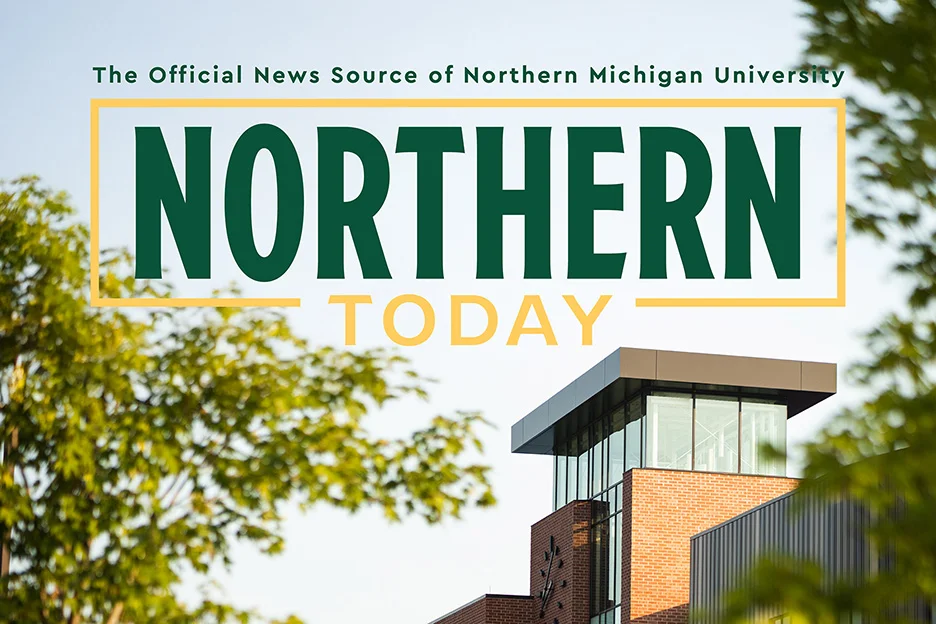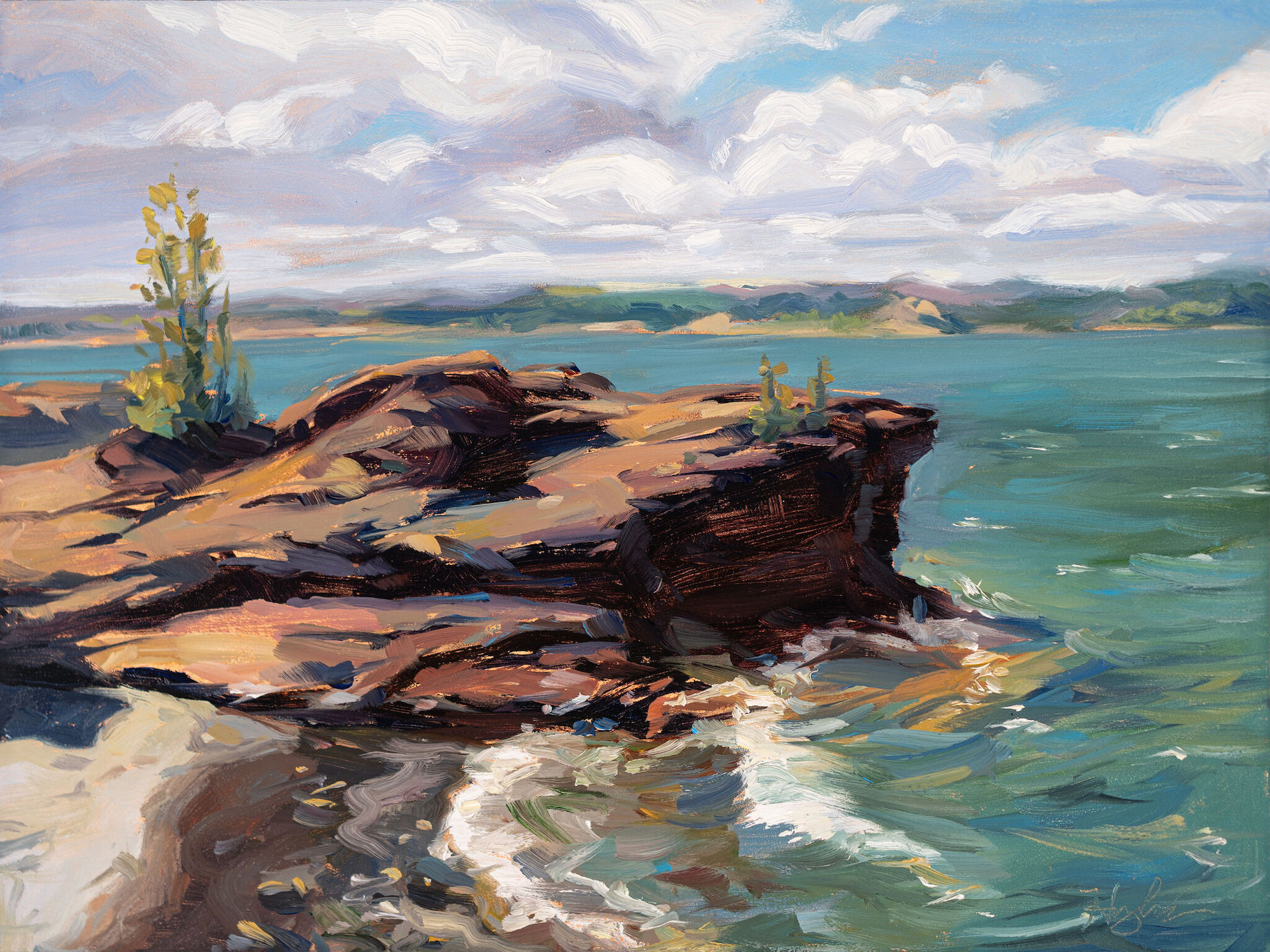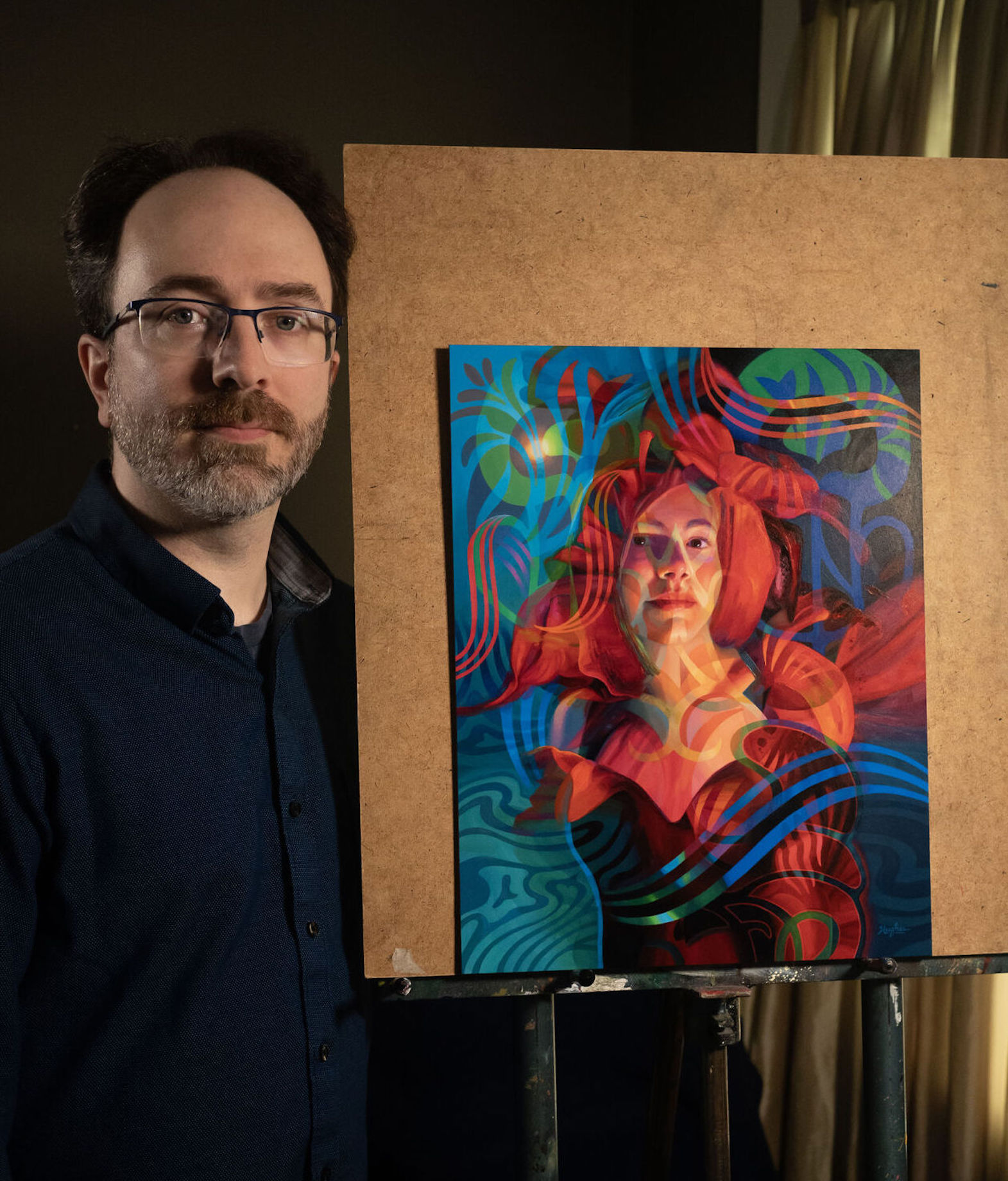Northern Michigan University Art and Design Professor Steve Hughes, whose freelance studio has the appropriate moniker Primary Hughes, has received some notable accolades for his boldly colorful acrylic paintings that meld portraiture with graphic elements and patterns. Most recently, he was selected as a monthly winner in the Figure & Portrait category of the 14th Annual PleinAir Salon Art Competition. He will compete for a $15,000 grand prize and a chance to have his work featured on the cover of PleinAir Magazine at a convention and expo in May.
The piece Hughes entered in the competition, “Tourmaline,” was the first, largest and most complex painting in a series he had created for his second solo exhibition at San Francisco's Modern Eden Gallery last fall. The series gained additional exposure when it was featured as a Chosen Winner in the online American Illustration 43 show earlier this year.
“I really like portraiture and find it endlessly fascinating because the face is full of character,” said Hughes, a past recipient of an NMU reassigned time award and faculty research grant to support his gallery exhibitions. “I've been exploring ways to disrupt the form and play with subtle variations in color and temperature to see how that affects what the actual figure looks like. Ultimately, it seems to add something more inventive. I take it further by playing with photography and floral imagery, as well as some automotive detail shots of car grills and other elements.
“I have one painting from my first show at Modern Eden Gallery that incorporates the Fresnel lens from the Marquette Maritime Museum. And then I weave graphic shapes and patterns into a tapestry to get a surprising interaction of color. That's what really inspires me. It is a portrait formally, but it's also very much an abstraction.”
The creative process for Hughes' portraits begins with photographs he takes of the models, flowers, car details and other graphic shapes. He incorporates technology such as Adobe Illustrator and Photoshop to create repeated, wallpaper-type print patterns and then layer the elements at various transparency levels. The resulting mockup is what he ends up painting.
Over the summer, Hughes' work was showcased in the “Character in Context” exhibition at the A.R. Mitchell Museum of Western Art in Trinidad, Colo. Billed as the largest exhibition of original illustration in the western United States, the show included artists' process works alongside the final versions. Hughes said he was honored to be featured alongside some of his artistic heroes, including Greg Manchess, who visited NMU's School of Art and Design in 2021 to present a couple of lectures and demonstrations.
Hughes' past achievements include freelance illustrations for clients that have included The New York Times and U.S. Mint. His painting of actor Daniel Day-Lewis as the character Bill the Butcher from the film Gangs of New York was exhibited in a show celebrating the movies of Martin Scorsese, and then acquired by the acclaimed director.
When he is not in an NMU classroom or his studio, Hughes often heads outdoors to complete plein-air paintings at Presque Isle Park or elsewhere along the Lake Superior shoreline.
“It is a nice break from both the precision required of a portrait and being stuck in an artificial environment,” he said. “You feel the breeze on your neck and sun on your face, and there's a sense of freedom in knowing not everything has to be exactly perfect. It doesn't matter if a branch is lower than it should be. I've probably done close to 200 landscape paintings over about the last decade, starting with watercolor and then switching to oil a few years ago. Presque Isle Park has been my main focus because there's good diversity with surface rocks, trees, little grassier areas, and then obviously the water. Despite the differences in precision and style, some of my plein-air techniques have carried over to my portrait work and affect how I paint with acrylics.”
Like many artists, Hughes spent much time drawing during his childhood. He went to college originally planning to become a graphic designer, but found the required illustration classes more interesting. He earned an MFA in visual communication design with a concentration in illustration from Kent State University.
Hughes approaches his role as an NMU professor with the goal of being open to students' ideas and supportive of their goals. He doesn't try to force a specific “look” upon the illustration program or want students to mimic his style. Instead, he guides them loosely in finding their own artistic voice that is consistently reflected in their work.
“I give them problems to solve, and certain requirements that would mimic what they might confront in the real world. For example, client specs can dictate permissible colors or specific parameters. Those are restrictions they ultimately have to problem-solve around and as much as possible, trying to meet the clients' goals for the project while satisfying their own creative interests," he said.
"I would say storytelling with their art is my mantra. If it's not telling a story, then it literally is just a representation of something that maybe doesn't capture anyone's interest long term. We want to stop people in their tracks and make them pay attention.”
One topic on students' minds that Hughes did not confront in college is Artificial Intelligence (AI). He openly expresses concerns about the ramifications of the pervasive technology for those who work in the creative sphere. He said AI is starting to “cannibalize” some of the early job opportunities that allow students to get paid a little while they learn, grow and refine their skills.
“Clients either don't see a difference from what AI is producing or actually prefer AI's slick kind of look, so students are going to have to find other ways to come up with their own projects to demonstrate their voice, make a name for themselves and generate some income. There's also the capitalistic nature of trying to get more for less. AI can quickly whip up things that people don't have to pay for.
"Corporations initially espoused the idea they were developing AI for the benefit of society—and it does offer some promise in health care and other important areas—but they're making a lot of money off of it, and in the process didn't ask for anyone's consent to have their imagery, words or other creative work used in this manner. U.S. copyright law didn't foresee this, either, so there is a lot of unjust, unlicensed use of creative works occurring. I believe art in general has a humanity to it that I'm just not ready to remove from the equation.”
View more of his work at primaryhughes.com.



